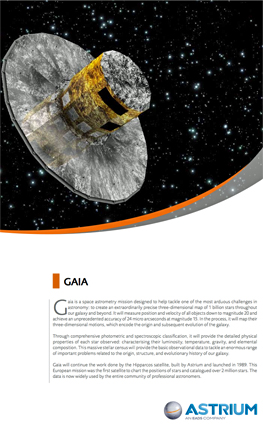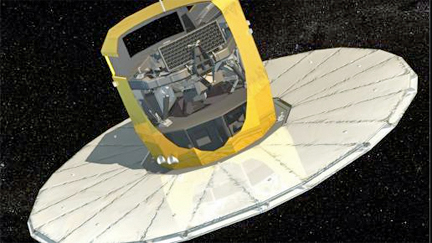
[SatNews] Astrium has finalized its preparation of Gaia in Kourou, French Guiana—Europe’s most advanced space telescope is scheduled for launch on December 19th aboard Soyuz.

Artistic rendition of the Gaia satellite.
Image courtesy of Astrium.
Designed and built by Astrium for the European Space Agency (ESA), Gaia will produce a highly accurate 3D map of our galaxy, the Milky Way, and discover and map objects far beyond its boundaries. Its goal is to improve our understanding of the origins and evolution of the Solar System. The Gaia mission is also expected to discover hundreds of thousands of unknown celestial objects, including extra-solar planets and failed stars, known as brown dwarfs. Within our solar system, Gaia will be able to identify tens of thousands of additional asteroids.
“Gaia is a truly galactic microscope, serving as the eyes of the Universe!” said Eric Beranger, CEO Astrium Satellites. “Gaia is also an exceptional space system. The precision of its instruments is such that Astrium’s engineers had to surpass themselves to design a structure of unprecedented stability, reaching a ‘quantum leap’ in mastering technologies. I’m extremely impressed by the extraordinary work they have accomplished in the past 10 years.”
Gaia will carry ultra-modern instruments, including the most sensitive telescope ever made. Like the space telescope on ESA’s Herschel mission, as well as all the instruments made by Astrium for Earth observation missions, this cutting-edge equipment is the result of unique expertise developed by Astrium in the field of silicon carbide (SiC) telescopes. As part of this remarkable success story, Astrium and its partner Boostec have created a new economic sector through their space-industry achievements. The SiC produced in the French Midi-Pyrénées region is exported around the world.
Gaia will also use a ‘photographic’ sensor of unprecedented accuracy. The precision of the measurements taken by Gaia’s optical instruments will be extremely high. For instance, Gaia would be capable of picking out a strand of hair from a distance of 700 kilometers, the equivalent of the altitude of Earth observation satellites, thanks to its huge focal plane made up of 106 CCD detectors gathering 1 billion pixels. For its attitude control, the spacecraft will use a cold gas propulsion system (nitrogen) with micro-thrusters, enabling it to remain perfectly stable and point with the required extreme accuracy.
Gaia will be located at one of the five Lagrangian points in the Sun-Earth system, at the L2 point. The Lagrangian points in our solar system are points of gravitational balance where a body such as a spacecraft orbits around the Sun at the same rate as Earth, thereby remaining in a fixed position relative to the Earth-Sun line. Located 1.5 million kilometers from Earth, these points are vital for astronomy observation missions, which require high pointing stability.

